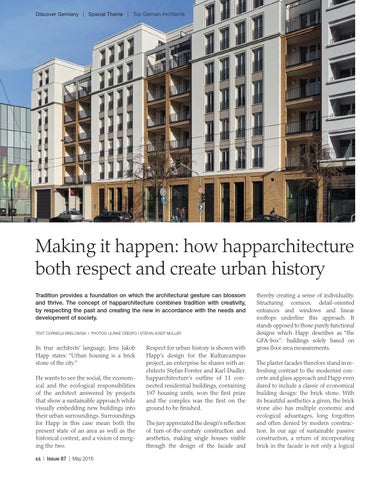Discover Germany | Special Theme | Top German Architects
Making it happen: how happarchitecture both respect and create urban history Tradition provides a foundation on which the architectural gesture can blossom and thrive. The concept of happarchitecture combines tradition with creativity, by respecting the past and creating the new in accordance with the needs and development of society. TEXT: CORNELIA BRELOWSKI I PHOTOS: ULRIKE CRESPO I STEFAN JOSEF MÜLLER
In true architects’ language, Jens Jakob Happ states: “Urban housing is a brick stone of the city.” He wants to see the social, the economical and the ecological responsibilities of the architect answered by projects that show a sustainable approach while visually embedding new buildings into their urban surroundings. Surroundings for Happ in this case mean both the present state of an area as well as the historical context, and a vision of merging the two. 66 | Issue 87 | May 2016
Respect for urban history is shown with Happ’s design for the Kulturcampus project, an enterprise he shares with architects Stefan Forster and Karl Dudler. happarchitecture’s outline of 11 connected residential buildings, containing 197 housing units, won the first prize and the complex was the first on the ground to be finished. The jury appreciated the design’s reflection of turn-of-the-century construction and aesthetics, making single houses visible through the design of the facade and
thereby creating a sense of individuality. Structuring cornices, detail-oriented entrances and windows and linear rooftops underline this approach. It stands opposed to those purely functional designs which Happ describes as “the GFA-box”: buildings solely based on gross floor area measurements. The plaster facades therefore stand in refreshing contrast to the modernist concrete and glass approach and Happ even dared to include a classic of economical building design: the brick stone. With its beautiful aesthetics a given, the brick stone also has multiple economic and ecological advantages, long forgotten and often denied by modern construction. In our age of sustainable passive construction, a return of incorporating brick in the facade is not only a logical
